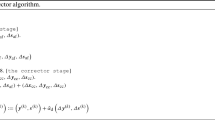Abstract
A sparsity preserving LP-based SOR method for solving classes of linear complementarity problems including the case where the given matrix is positive-semidefinite is proposed. The LP subproblems need be solved only approximately by a SOR method. Heuristic enhancement is discussed. Numerical results for a special class of problems are presented, which show that the heuristic enhancement is very effective and the resulting program can solve problems of more than 100 variables in a few seconds even on a personal computer.
Similar content being viewed by others
References
Chung, S. J., andMurty, K. G.,Polynomially Bounded Ellipsoid Algorithms for Convex Quadratic Programming, Nonlinear Programming 4, Edited by O. L. Mangasarian, R. R. Meyer, and S. M. Robinson, Academic Press, New York, New York, pp. 439–485, 1981.
Dantzig, G. B., andCottle, R. W.,Positive Semidefinite Programming, Nonlinear Programming, Edited by J. Abadie, North-Holland Publishing Company, Amsterdam, Holland, pp. 55–73, 1967.
Lemke, C. E.,On Complementary Pivot Theory, Mathematics of the Decision Sciences, Part 1, Edited by G. B. Dantzig and A. F. Veinott, American Mathematical Society, Providence, Rhode Island, pp. 95–114, 1968.
Shiau, T. H.,Iterative Linear Programming for Linear Complementarity and Related Problems, University of Wisconsin, Madison, Wisconsin, Computer Sciences Department, PhD Thesis, 1983.
Ahn, B. H.,Solution of Nonsymmetric Linear Complementarity Problems by Iterative Methods, I, Journal of Optimization Theory and Applications, Vol. 33, pp. 175–185, 1981.
Cheng, Y. C.,Iterative Methods for Solving Linear Complementarity and Linear Programming Problems, University of Wisconsin, Madison, Wisconsin, PhD Thesis, 1981.
Cottle, R. W., Golub, G. H., andSacher, R. S.,On the Solution of Large Structured Complementarity Problems, Applied Mathematics and Optimization, Vol. 4, pp. 347–363, 1978.
Cryer, C. W.,The Solution of a Quadratic Programming Problem Using Systematic Overrelaxation, SIAM Journal on Control, Vol. 9, pp. 385–392, 1971.
Mangasarian, O. L.,Solution of Symmetric Linear Complementarity Problems by Iterative Methods, Journal of Optimization Theory and Applications, Vol. 22, pp. 465–485, 1977.
Cottle, R. W., andDuvall, S. G.,A Lagrangian Relaxation Algorithm for the Constrained Matrix Problem, Stanford University, Stanford, California, Systems Optimization Laboratory, Report No. 82-10, 1982.
Han, S. P., andMangasarian, O. L.,A Dual Differentiable Exact Penalty Function, Mathematical Programming, Vol. 25, pp. 293–306, 1983.
Pang, J. S.,On the Convergence of a Basic Iterative Method for the Implicit Complementarity Problem, Journal of Optimization Theory and Applications, Vol. 17, pp. 149–162, 1982.
Frank, M., andWolfe, P.,An Algorithm for Quadratic Programming, Naval Research Logistics Quarterly, Vol. 3, pp. 95–110, 1956.
Mangasarian, O. L., andShiau, T. H.,Error Bounds for Monotone Linear Complementarity Problems, Mathematical Programming, Vol. 36, pp. 81–89, 1986.
Karmarkar, N.,A New Polynomial-Time Algorithm for Linear Programming, Combinatorica, Vol. 4, pp. 373–395, 1984.
Agmon, S.,The Relaxation Method for Linear Inequalities, Canadian Journal of Mathematics, Vol. 6, pp. 382–392, 1954.
Motzkin, T. S., andSchoenberg, I. J.,The Relaxation Method for Linear Inequalities, Canadian Journal of Mathematics, Vol. 6, pp. 393–404, 1954.
Censor, Y., andLent, A.,A Cyclic Subgradient Projections Method for the Convex Feasibility Problem, University of Haifa, Mount Carmel, Haifa, Israel, Department of Mathematics, Technical Report, 1980.
Ortega, J. M.,Numerical Analysis, A Second Course, Academic Press, New York, New York, 1972.
Varga, R. S.,Matrix Iterative Analysis,Prentice-Hall, Englewood Cliffs, New Jersey, 1962.
Author information
Authors and Affiliations
Additional information
Communicated by O. L. Mangasarian
This research was sponsored by the Air Force Office of Scientific Research, Grant No. AFOSR-86-0124. Part of this material is based on work supported by the National Science Foundation under Grant No. MCS-82-00632.
The author is grateful to Dr. R. De Leone for his helpful and constructive comments on this paper.
Rights and permissions
About this article
Cite this article
Shiau, T.H. An LP-based successive overrelaxation method for linear complementarity problems. J Optim Theory Appl 59, 247–259 (1988). https://doi.org/10.1007/BF00938311
Issue Date:
DOI: https://doi.org/10.1007/BF00938311




